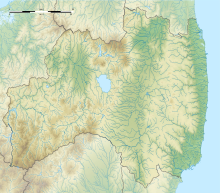Battle of Suriagehara
 Date clan
Date clan Katakura clan
Katakura clan Tamura clan
Tamura clan Iwaki clan
Iwaki clan Ashina clan
Ashina clan Satake clan
Satake clan Sōma clan
Sōma clan Nikaidō clan
Nikaidō clan Date Masamune
Date Masamune Date Shigezane
Date Shigezane Katakura Kagetsuna
Katakura Kagetsuna Oniniwa Tsunamoto
Oniniwa Tsunamoto Ashina Yoshihiro
Ashina Yoshihiro Satake Yoshishige
Satake Yoshishige Satake Yoshinobu
Satake Yoshinobu Sōma Yoshitane
Sōma Yoshitane Onamihime
Onamihime



Battle of Suriagehara (摺上原の戦い, Suriagehara no tatakai) was a battle during the Sengoku period (16th century) of Japan. It was fought at a field called Suriagehara, whose modern location is split between the towns of Inawashiro and Bandai in Fukushima Prefecture.
Background
The Battle of Suriagehara served as the aftermath of the Siege of Kurokawa, in which Ashina Yoshihiro with aid from Satake clan and Nikaidō clan, his 16,000 men stole the moment to enact revenge for their previous defeat at Kurokawa Castle.
Battle
Date Masamune, with his superior 23,000 troops, defeated the Ashina.[1] While some Ashina forces withdrew across the Nippashi River to Kurokawa, the bridge gave out amidst their retreat, leaving many Ashina troops to be cut down when the Date forces overtook them. According to the 17th century text Ōū Eikei Gunki, there were around 500 Ashina troops killed at the Nippashi River alone.
Aftermath
This battle helped seal the Date clan's hegemony over southern Mutsu Province. However, despite the victory, resistance after the battle continued, notably from the pro-Ashina, Nikaidō and Satake clans.
The battle later served as the basis for the Noh play "Suriage." According to local lore, the Tohoku folk song "Sansa Shigure" was written by Masamune in the celebrations following this Date victory.
References
- ^ Turnbull, Stephen (1998). The Samurai Sourcebook. London: Cassell & Co. p. 241. ISBN 9781854095237.
- Date Shigezane. Shigezane-ki. pp. 207-329 of Sendai Sōsho Volume 3. Sendai: Sendai Sōsho Kankōkai, 1923.
- v
- t
- e










